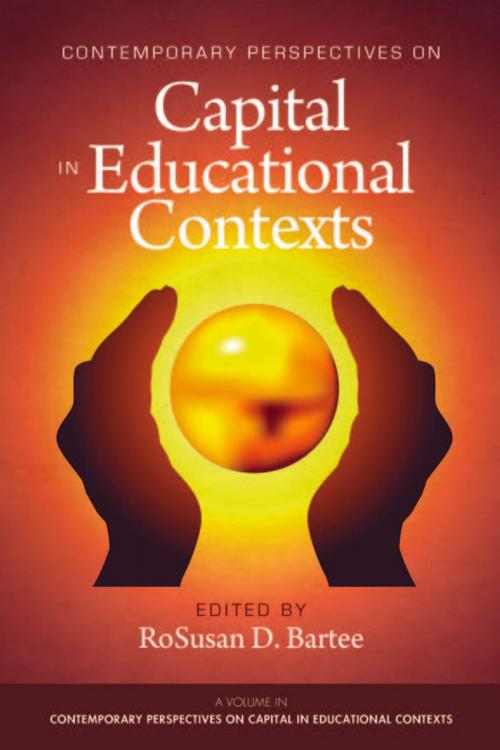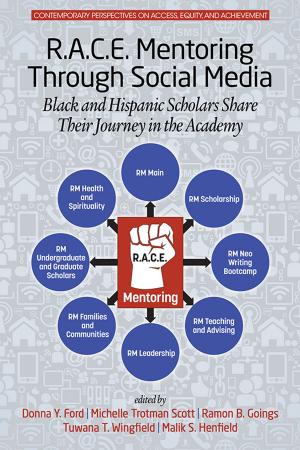Contemporary Perspective on Capital in Educational Contexts
Nonfiction, Reference & Language, Education & Teaching, Administration| Author: | ISBN: | 9781617353659 | |
| Publisher: | Information Age Publishing | Publication: | August 1, 2010 |
| Imprint: | Information Age Publishing | Language: | English |
| Author: | |
| ISBN: | 9781617353659 |
| Publisher: | Information Age Publishing |
| Publication: | August 1, 2010 |
| Imprint: | Information Age Publishing |
| Language: | English |
The edited volume, Contemporary Perspectives on Capital in Educational Contexts, is timely in its unique and appropriate analyses of the prevailing internal and external dynamics of capital as indicative of the type of currency within institutional structures or the currency among individual stakeholders of education. The intersection of capital and currency emerges similarly and differently within the American compulsorybased system of K12 and the choicebased system of higher education. More specifically, Contemporary Perspectives on Capital in Educational Contexts disentangles the broader challenges and opportunities of the institution of education and the individuals who comprise. Emerging insights from the analyses provide an informed basis for ascertaining the rules of engagement and means of negotiation for the respective constituencies. With that said, this volume essentially responds to three important questions: 1) What are the tenets of capital and currency in public schools and higher education?; 2 ) How do institutions and individuals navigate those tenets?; and 3) What general and specific implications do capital hold for the educational pipeline and beyond? These questions provide a useful framework for engaging critical conversations about the dynamics of capital while offering perspectives about how to improve the quality of currency in K12 or colleges and universities. These questions further serve as a basis for eliciting more questions toward the consideration capital as both a conceptual construct and applicable model. Contemporary Perspectives on Capital in Educational Contexts, too, is an expansion of the work of School matters: Why African American students need multiple forms of capital, where Bartee & Brown (2006) examines how the acquisition and possession of capital equips African American students in a highperforming, highachieving magnet school in Chicago for competitiveness in schoolgenerated and nonschool generated activities. Success experienced by the students and the school become associated with the academic rigor and reputation while any shortcomings reflect an inadequate capacity of the school or the student to appropriately engage the other. School matters: Why African American students need multiple forms of capital (2006) further introduces an initial exploration of different forms of capital as producer (improve the status quo through inputs), consumer (participant based upon outputs), and regulator (maintain the status quo through the process) within the educational system. The multifaceted role of capital demonstrates its span of influence for institutional and individual capacities.
The edited volume, Contemporary Perspectives on Capital in Educational Contexts, is timely in its unique and appropriate analyses of the prevailing internal and external dynamics of capital as indicative of the type of currency within institutional structures or the currency among individual stakeholders of education. The intersection of capital and currency emerges similarly and differently within the American compulsorybased system of K12 and the choicebased system of higher education. More specifically, Contemporary Perspectives on Capital in Educational Contexts disentangles the broader challenges and opportunities of the institution of education and the individuals who comprise. Emerging insights from the analyses provide an informed basis for ascertaining the rules of engagement and means of negotiation for the respective constituencies. With that said, this volume essentially responds to three important questions: 1) What are the tenets of capital and currency in public schools and higher education?; 2 ) How do institutions and individuals navigate those tenets?; and 3) What general and specific implications do capital hold for the educational pipeline and beyond? These questions provide a useful framework for engaging critical conversations about the dynamics of capital while offering perspectives about how to improve the quality of currency in K12 or colleges and universities. These questions further serve as a basis for eliciting more questions toward the consideration capital as both a conceptual construct and applicable model. Contemporary Perspectives on Capital in Educational Contexts, too, is an expansion of the work of School matters: Why African American students need multiple forms of capital, where Bartee & Brown (2006) examines how the acquisition and possession of capital equips African American students in a highperforming, highachieving magnet school in Chicago for competitiveness in schoolgenerated and nonschool generated activities. Success experienced by the students and the school become associated with the academic rigor and reputation while any shortcomings reflect an inadequate capacity of the school or the student to appropriately engage the other. School matters: Why African American students need multiple forms of capital (2006) further introduces an initial exploration of different forms of capital as producer (improve the status quo through inputs), consumer (participant based upon outputs), and regulator (maintain the status quo through the process) within the educational system. The multifaceted role of capital demonstrates its span of influence for institutional and individual capacities.















